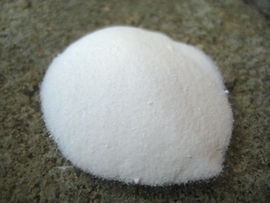Sodium dithionite

| |
| Names | |
|---|---|
| IUPAC name
Sodium dithionite
| |
| Systematic IUPAC name
Sodium dithionite | |
| Other names
D-Ox
Hydrolin Reductone Sodium hydrosulfite Sodium sulfoxylate Sulfoxylate Vatrolite Virtex L | |
| Properties | |
| Na2S2O4 | |
| Molar mass | 174.107 g/mol (anhydrous) 210.146 g/mol (dihydrate) |
| Appearance | White to grayish crystalline solid |
| Odor | Faint sulfurous odor |
| Density | 2.38 g/cm3 (anhydrous) 1.58 g/cm3 (dihydrate) |
| Melting point | 52 °C (126 °F; 325 K) |
| Boiling point | Decomposes |
| Anhydrous 18.2 g/100 ml (20 °C) Dihydrate 21.9 g/100 ml (20 °C) | |
| Solubility | Slightly soluble in ethanol, methanol |
| Hazards | |
| Safety data sheet | Sigma-Aldrich |
| Flash point | 100 °C (212 °F; 373 K) |
| Related compounds | |
| Related compounds
|
Sodium metabisulfite Sodium thiosulfate |
| Except where otherwise noted, data are given for materials in their standard state (at 25 °C [77 °F], 100 kPa). | |
| Infobox references | |
Sodium dithionite or sodium hydrosulfite is a white crystalline powder with a weak sulfurous odor, used as reducing agent.
Contents
[hide]Properties
Chemical
Sodium dithionite reacts with oxygen in the presence of moisture:
- Na2S2O4 + O2 + H2O → NaHSO4 + NaHSO3
Sodium dithionite is stable when dry, but aqueous solutions deteriorate due to the following reaction:
- 2 S2O42− + H2O → S2O32− + 2 HSO3−
Anhydrous sodium dithionite decomposes to sodium sulfate and sulfur dioxide above 90 °C in air. In absence of air, it decomposes quickly if heated above 150 °C to sodium sulfite, sodium thiosulfate, sulfur dioxide and trace amount of sulfur.
Sodium dithionite is a reducing agent. At pH = 7, the potential is -0.66 V vs NHE. Redox occurs with formation of sulfite.
Physical
Sodium dithionite is a white-grayish solid, with a weak sulfurous odor.
Availability
It is sold by chemical suppliers.
Preparation
Can be prepared by reducing sulfur dioxide using various reducing agents, like zinc powder, sodium borohydride and formates.[1]
The preparation of this compound is relative complicated, due to its sensitivity to air, and you might need an inert atmosphere to prevent the loss of product. It's cheaper to simply purchase it if you need significant amounts of it.
Projects
- Reducing agent
- Bleach paper
Handling
Safety
Contact with this substance may produce irritations or burns.
Sodium hydrosulfite spontaneously heats on contact with air and moisture. The heat generated may be sufficient to ignite surrounding combustible materials.
Storage
In closed air-tight bottles, away from moisture.
Disposal
Can be neutralized with bleach or hydrogen peroxide.
References
Relevant Sciencemadness threads
- Interest Check: Sodium Dithionite, Na2S2O4 (Sodium Hydrosulfite)
- Sodum dithionite synthesis
- OTC source of sodium dithionite and synthesis
- Sodium dithionite
- Info on sodium dithionite please
- thoughts on practical reduction with dithionite
- how can I separate Sodium hydrosulfite and sodium bisulfite mixture?
- Dithionite Reductions